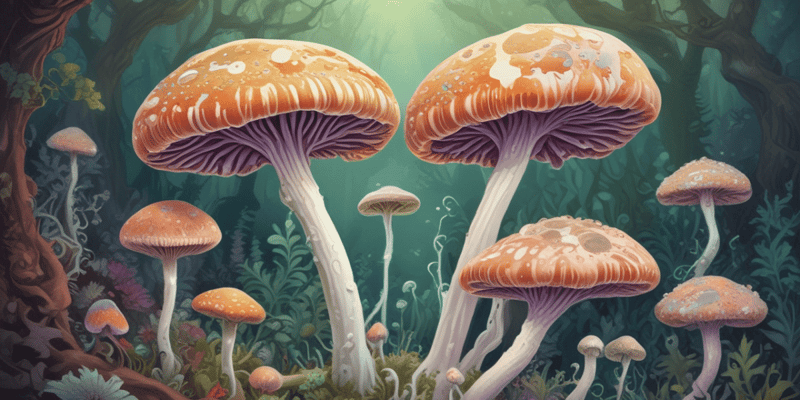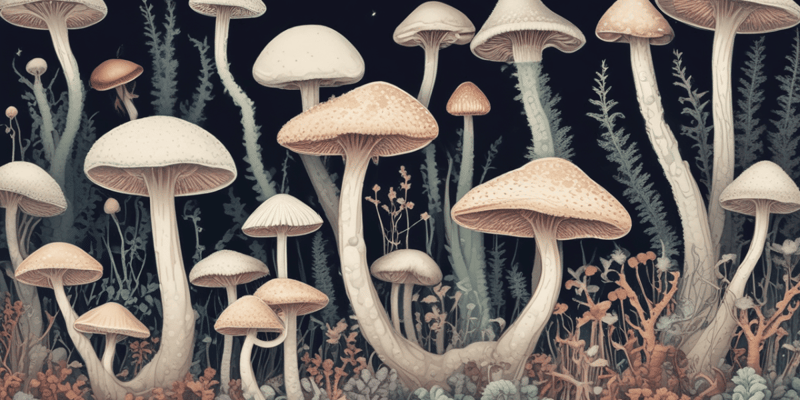Questions and Answers
Which characteristic distinguishes dimorphic fungi from other fungi?
Which of the following fungi is specifically known for causing cryptococcosis?
Tinea versicolor is caused by which type of fungus?
Invasive fungal infections often stem from which of the following features?
Signup and view all the answers
Which condition is primarily associated with Candida spp. infections in patients with urinary catheters?
Signup and view all the answers
Which of the following infections is NOT typically caused by Cryptococcus neoformans?
Signup and view all the answers
What is the primary treatment for severe Candida infections in immunosuppressed patients?
Signup and view all the answers
What distinguishes Pneumocystis jirovecii from other yeasts?
Signup and view all the answers
Which of the following is NOT a common characteristic of invasive fungal infections?
Signup and view all the answers
Which method is NOT commonly used for the diagnosis of systemic yeast infections?
Signup and view all the answers
Which statement is true regarding dermatophyte infections?
Signup and view all the answers
What is the characteristic clinical presentation of tinea versicolor?
Signup and view all the answers
Which of the following fungi is commonly associated with invasive infections?
Signup and view all the answers
What does the microscopy of a skin scraping from tinea versicolor typically show?
Signup and view all the answers
Which method is primarily used to identify dermatophyte species from cultures?
Signup and view all the answers
What is a common complication of dermatophyte infections of the foot?
Signup and view all the answers
Which of the following statements about Candida spp. is correct?
Signup and view all the answers
What is a major characteristic of Candida albicans in relation to mucocutaneous infections?
Signup and view all the answers
Which of the following is a key predisposing factor for dermatophyte infections?
Signup and view all the answers
What condition is associated with angular cheilitis?
Signup and view all the answers
What is the role of moisture in predisposing to dermatophyte infections?
Signup and view all the answers
Which population is NOT at increased risk for developing oral thrush?
Signup and view all the answers
What is Tinea Versicolor primarily caused by?
Signup and view all the answers
Which statement is true regarding invasive fungal infections?
Signup and view all the answers
In what way do Candida species behave in the skin and environment?
Signup and view all the answers
How does rapid colonization of Candida albicans occur on the skin?
Signup and view all the answers
Study Notes
Dimorphic Fungi
- Fungi that can exist as both yeast and mould depending on temperature.
- Includes systemic pathogens like Histoplasma capsulatum.
- Geographically limited in distribution, affecting certain regions.
Systemic Yeast Infections
- Commonly caused by Candida species.
- Urinary tract infections often related to urinary catheters.
- Endocarditis risks increase with prosthetic heart valves and IV drug use.
- Septicemia occurs in immunosuppressed individuals, potentially leading to chronic disseminated candidiasis.
- Disseminated candidiasis can affect solid organs and be detected in eye examinations.
Diagnosis of Yeast Infections
- Diagnosis relies on clinical suspicion, microscopy, culture, antigen detection, and imaging (e.g., CT, X-ray).
- Microscopy utilizes KOH and gram stains; cultures take days to weeks.
- Common treatments include fluconazole and nystatin for superficial infections.
Cryptococcus Species
- Cryptococcus neoformans is an encapsulated yeast that can cause mild pneumonia and severe meningitis, especially in immunocompromised patients.
- Found predominantly on Vancouver Island and surrounding areas.
Pneumocystis jirovecii
- A non-culturable yeast responsible for pneumonia in immunosuppressed patients, particularly those with HIV or malignancies.
Aspergillus Species
- Aspergillus fumigatus is a widespread mould found in decaying vegetation.
- Can cause various illnesses, especially in immunocompromised individuals.
Characteristics of Fungi
- Fungi belong to one of the five kingdoms and are eukaryotic organisms.
- Possess cell walls containing ergosterol; they lack chlorophyll.
- Reproduce both asexually and sexually.
Yeast and Mould Morphology
- Yeasts are single-celled, often elongating into chains (pseudohyphae) and reproduce via budding.
- Moulds are multicellular, forming hyphae that can be septate or aseptate, leading to mycelium development and asexual spore formation.
Clinical Features of Fungal Infections
- Fungal infections may present as red, scaly rashes with pustules and central clearing, known as "ringworm," "athlete's foot," or "jock itch."
- Transmission occurs through contaminated fomites or skin squames, with rare person-to-person contact.
Diagnosis of Dermatophyte Infections
- Involves skin scrapings, nail clippings, and hair samples, employing KOH microscopy for hyphae identification.
- Cultures can take weeks, with characteristic spores aiding in speciation.
Tinea Versicolor
- Caused by Malassezia furfur, a skin commensal thriving on fatty acids.
- Presents as pigmented lesions and can be diagnosed via microscopy showing "spaghetti and meatballs" patterns in KOH preparations.
Invasive Fungal Infections
- Two main categories: opportunistic fungi (e.g., Candida, Aspergillus) and non-opportunistic pathogens.
- Infections can occur through damage, allergy, toxin ingestion, or body invasion.
Mucocutaneous Yeast Infections
- Predominantly caused by Candida albicans and may affect the oral cavity, vagina, and gastrointestinal tract.
- Conditions like thrush and angular cheilitis are associated with various immunocompromised states.
Skin and Nail Infections
- Superficial infections often caused by Candida, presenting in damp areas or due to hygiene issues.
- Dermatophytes can lead to skin, nail, and hair infections, often following minor skin trauma.
Predisposing Factors for Fungal Infections
- Include minor trauma, moisture retention, and occlusive environments, which facilitate infection onset and progression.
Studying That Suits You
Use AI to generate personalized quizzes and flashcards to suit your learning preferences.
Description
Test your knowledge on dimorphic fungi, specifically Histoplasma capsulatum, and systemic yeast infections such as those caused by Candida spp. This quiz will cover the associations of these infections, their presentation, and risk factors related to various medical conditions.




